
Fritillaria (fritillaries) is a genus of spring flowering herbaceous bulbous perennial plants in the lily family (Liliaceae). The type species, Fritillaria meleagris, was first described in Europe in 1571, while other species from the Middle East and Asia were also introduced to Europe at that time. The genus has about 130–140 species divided among eight subgenera. The flowers are usually solitary, nodding and bell-shaped with bulbs that have fleshy scales, resembling those of lilies. They are known for their large genome size and genetically are very closely related to lilies. They are native to the temperate regions of the Northern hemisphere, from the Mediterranean and North Africa through Eurasia and southwest Asia to western North America. Many are endangered due to enthusiastic picking.

Fritillaria meleagris is a Eurasian species of flowering plant in the lily family. Its common names include snake's head fritillary, snake's head, chess flower, frog-cup, guinea-hen flower, guinea flower, leper lily, Lazarus bell, chequered lily, chequered daffodil, drooping tulip or, in northern Europe, simply fritillary. The plant is native to the flood river plains of Europe where it grows in abundance.

Spiraea, sometimes spelled spirea in common names, and commonly known as meadowsweets or steeplebushes, is a genus of about 80 to 100 species of shrubs in the family Rosaceae. They are native to the temperate Northern Hemisphere, with the greatest diversity in eastern Asia.

Berberis, commonly known as barberry, is a large genus of deciduous and evergreen shrubs from 1–5 m (3.3–16.4 ft) tall, found throughout temperate and subtropical regions of the world. Species diversity is greatest in South America and Asia; Europe, Africa and North America have native species as well. The best-known Berberis species is the European barberry, Berberis vulgaris, which is common in Europe, North Africa, the Middle East, and central Asia, and has been widely introduced in North America. Many of the species have spines on the shoots and all along the margins of the leaves.

Ilex verticillata, the winterberry, is a species of holly native to eastern North America in the United States and southeast Canada, from Newfoundland west to Ontario and Minnesota, and south to Alabama.

Berberis thunbergii, the Japanese barberry, Thunberg's barberry, or red barberry, is a species of flowering plant in the barberry family Berberidaceae, native to Japan and eastern Asia, though widely naturalized in China and North America. Growing to 1 m (3.3 ft) tall by 2.5 m (8.2 ft) broad, it is a small deciduous shrub with green leaves turning red in the autumn, brilliant red fruits in autumn and pale yellow flowers in spring. Numerous cultivars are available as ornamental plants suitable for hedging.

Mollugo verticillata, the green carpetweed, is a rapidly spreading annual plant from tropical America. In eastern North America, it is a common weed growing in disturbed areas. It forms a prostrate circular mat that can quickly climb over nearby plants and obstacles. The species has been reported from every state in the United States except Alaska, Hawaii, and Utah, as well as from British Columbia, Manitoba. Ontario, Quebec, New Brunswick and Nova Scotia. Although considered an invasive weed, M.verticillata is also known to be edible. Archaeological evidence has shown that M. verticillata has been in North America for about 3000 years. Sometimes also referred to as "Indian chickweed", in China this plant is referred to as zhong leng su mi cao.
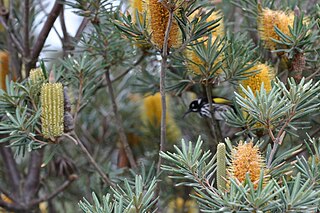
Banksia verticillata, commonly known as granite banksia or Albany banksia, is a species of shrub or (rarely) tree of the genus Banksia in the family Proteaceae. It is native to the southwest of Western Australia and can reach up to 3 m (10 ft) in height. It can grow taller to 5 m (16 ft) in sheltered areas, and much smaller in more exposed areas. This species has elliptic green leaves and large, bright golden yellow inflorescences or flower spikes, appearing in summer and autumn. The New Holland honeyeater is the most prominent pollinator, although several other species of honeyeater, as well as bees, visit the flower spikes.
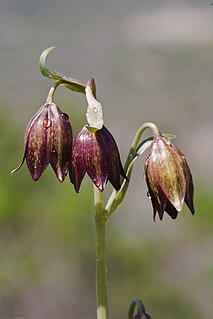
Fritillaria biflora is a species of fritillary native to western California and northern Baja California. It occurs in the chaparral and woodlands ecoregion, often in serpentine soil formations and hillside grassland habitats.
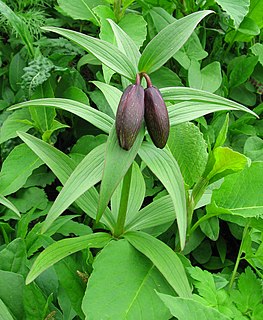
Fritillaria camschatcensis is a species of fritillary native to northeastern Asia and northwestern North America, including northern Oregon, Washington, British Columbia, Alaska, northern Japan, and the Russian Far East. It has many common names, including Kamchatka fritillary and Kamchatka lily.

Malva verticillata, also known as the Chinese mallow or cluster mallow, is a species of the mallow genus Malva in the family of Malvaceae found in East Asia from Pakistan to China. M. verticillata is an annual or biennial that grow up to 1.7 meters in high and can inhabit woodland areas of different soil types. The small, symmetrical flowers have five white, pink or red petals (0.8 cm) and 13 or more stamens. Each flower has 3 narrow epicalyx bracts. The fruit is a dry, hairless nutlet. The leaves are simple and alternate.
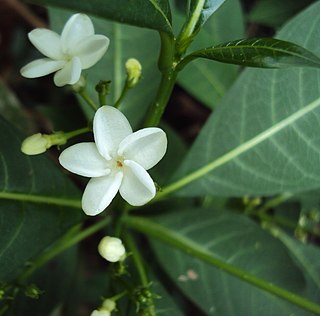
Rauvolfia verticillata, the common devil pepper, is a plant in the family Apocynaceae. The specific epithet verticillata means "whorled" and refers to the plant's leaves.
Fritillaria cirrhosa, common name yellow Himalayan fritillary, is an Asian species of herbaceous plant in the lily family, native to China, the Indian Subcontinent, and Myanmar.
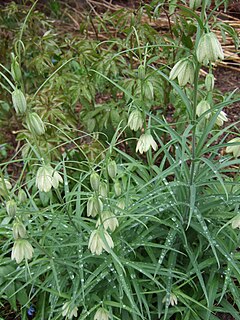
Fritillaria thunbergii is an Asian plant species of the lily family. It is native to Kazakhstan and in Xinjiang Province of western China, though cultivated in other places and naturalized in Japan and in other parts of China.
Fritillaria tortifolia is a Chinese plant species of the lily family. It is found only in the northwestern part of Xinjiang Province, the extreme northwestern corner of China.

Rosa abyssinica is a rose native to sub-Saharan Africa. Non-Africans first learned of the rose in the writings of 19th-century Scottish botanist Robert Brown. Rosa abyssinica is included in the genus Rosa, and the family Rosaceae. No subspecies are listed in the Catalogue of Life.

Fritillaria sewerzowii is a perennial herbaceous bulbous plant, distributed in alpine areas of central Asia. It is a species in the genus Fritillaria, in the family Liliaceae. It is placed in the subgenus Korolkowia.

Fritillaria dagana is a rare perennial herbaceous bulbous plant, distributed in Siberia. It is a species in the genus Fritillaria of the family Liliaceae. It is placed in the subgenus Liliorhiza.

Fritillari japonica is a perennial herbaceous bulbous plant, endemic to Japan. It is a species in the genus Fritillaria, in the family Liliaceae. It is placed in the subgenus Japonica.

















